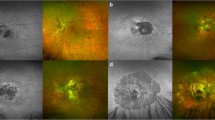Abstract
Purpose: To characterize changes in fundus autofluorescence in patientswith pseudoxanthoma elasticum (PXE). Fundus autofluorescence intrinsicallyderives from lipofuscin, and the degree of autofluorescence is thought to indicatethe degree of retinal pigment epithelium (RPE) metabolic activity. Methods:Twelve eyes of 6 patients (2 men, 4 women) with PXE were studied with aconfocal scanning laser ophthalmoscope. Patient age ranged from 42 to 62years. The autofluorescence of abnormal retinal areas was compared digitallywith that of neighboring, presumed healthy control areas. When the averagegray level of a fundus region was 2 SDs above or below the average graylevel of a control area, autofluorescence of the fundus region was consideredabnormal. Results: In all 12 eyes, some segments of the angioid streaksshowed decreased fundus autofluorescence, and other segments of the streaksshowed normal autofluorescence. Areas of peripapillary chorioretinal atrophyseen in 2 eyes and of disciform scarring seen in 3 eyes showed decreasedautofluorescence. Solitary or multiple drusen-like spots showed increasedautofluorescence in all 12 eyes. Conclusion: Atrophic and degenerativeRPE regions showed decreased fundus autofluorescence in areas of chorioretinalatrophy and in some segments of the angioid streaks. Some drusen-like spotsshowed increased autofluorescence. The characteristic changes in autofluorescencethat we observed in PXE patients suggest that the content of the drusen-like substancediffers from that of senile drusen and that the drusen-like lesions are similar to thesub-RPE deposits seen in macular dystrophy.
Similar content being viewed by others
References
von Ruckman A, Fitzke FW, Bird AC. Autofluorescence imaging of the human fundus. In: Marmor MF, Wolfensberger TJ (eds). The retinal pigment epithelium. </del>Function and disease. New York: Oxford University Press, 1998: 224–34.
von Ruckmann A, Fitzke FW, Bird AC. Distribution of fundus autofluorescence with a scanning laser ophthalmoscope. Br J Ophthalmol 1995; 79: 407–12.
Solbach U, Keilhauer C, Knabben H, Wolf S. Imaging of retinal autofluorescence in patients with age-related macular degeneration. Retina 1997; 17: 385–9.
von Ruckmann A, Fitzke FW, Bird AC. Fundus autofluorescence in age-related macular disease imaged with a laser scanning ophthalmoscope. Invest Ophthalmol Vis Sci 1997; 38: 478–86.
Spital G, Radermacher M, Muller C, Brumm G, Lommatzsch A, Pauleikhoff D. Autofluorescence characteristics of lipofuscin components in different forms of late senile macular degeneration [in German]. Klin Monatsbl Augenheilkd 1998; 213: 23–31.
von Ruckmann A, Fitzke FW, Gregor ZJ. Fundus autofluorescence in patients with macular holes imaged with a laser scanning ophthalmoscope. Br J Ophthalmol 1998; 82: 346–51.
von Ruckmann A, Schmidt K-G, Fitzke FW, Bird AC, Jacobi KW. Autofluorescence of the retinal pigment epithelium in patients with central serous chorioretinopathy [in German]. Ophthalmologe 1999; 96: 6–10.
Bellmann C, Holz FG, Breitbart A, Volcker HE. Bilateral acute syphilitic posterior placoid chorioretinopathy-angiographic and autofluorescence characteristics [in German]. Ophthalmologe 1999; 96: 522–8.
von Ruckmann A, Fitzke FW, Bird AC. In vivo fundus auto-fluorescence in macular dystrophies. Arch Ophthalmol 1997; 115: 609–15.
Downes SM, Fitzke FW, Holder GE, Payne AM, Bessant DAR, Bhattacharya SS, et al. Clinical features of codon 172 RDS macular dystrophy: Similar phenotype in 12 families. Arch Ophthalmol 1999; 117: 1373–83.
Goodman RM, Smith EW, Paton D, Bergman RA, Siegel CL, Ottesen OE, et al. Pseudoxanthoma elasticum: a clinical and histopathological study. Medicine 1963; 42: 297–334.
Gills JP, Paton D. Mottled fundus oculi in pseudoxanthoma elasticum: a report on two siblings. Arch Ophthalmol 1965; 73: 792–5.
Smith JL, Gass JDM, Justice J Jr. Fluorescein fundus angiography of angioid streaks. Br J Ophthalmol 1964; 48: 517–21.
McKusick VA. Heritable disorders of connective tissue. VI Pseudoxanthoma elasticum. J Chronic Dis 1956; 3: 263–83.
Verhoff FH. Histological findings in a case of angioid streaks. Br J Ophthalmol 1948; 32: 531–44.
Meislik J, Neldner K, Reeve EB, Ellis PP. Atypical drusen in pseudoxanthoma elasticum. Ann Ophthalmol 1979; 11: 653–6.
Mansour AM, Annesley WH. Comet-tailed drusen of the retinal pigment epithelium in angioid streaks. Eye 1998; 12: 943–4.
Erkkila H, Raitta C, Niemi KM. Ocular findings in four siblings with pseudoxanthoma elasticum. Acta Ophthalmol (Copenh) 1983; 61: 589–99.
Krill AE, Klien BA, Archer DB. Precursors of angioid streaks. Am J Ophthalmol 1973; 76: 875–9.
Patnaik B, Malik SRK. Fluorescein fundus photography of angioid streaks. Br J Ophthalmol 1971; 55: 833–7.
Steinmetz RL, Garner A, Maguire JI, Bird AC. Histopathology of incipient fundus flavimaculatus. Ophthalmology 1991; 98: 953–6.
Struk B, Neldner KH, Rao VS, St Jean P, Lindpaintner K. Mapping of both autosomal recessive and dominant variants of pseudoxanthoma elasticum to chromosome 16p13.1. Hum Mol Genet 1997; 6: 1823–8.
van-Soest S, Swart J, Tijmes LA, Sandkuijl LA, Rommers J, Bergen AAB. A locus for autosomal recessive pseudoxanthoma elasticum, with penetrance of vascular symptoms in carriers, maps to chromosome 16p13.1. Genome Res 1997; 7: 830–4.
Fazio MJ, Mattei MG, Passage ML, Chu ML, Black D, Solomon E, et al. Human elastin gene: new evidence for localization to the long arm of chromosome 7. Am J Hum Genet 1991; 48: 696–703.
Quaglino D, Boraldi F, Barbieri D, Croce A, Tiozzo R, Ronchetti IP. Abnormal phenotype of in vitro dermal fibroblasts from patients with pseudoxanthoma elasticum (PXE). Biochim Biophys Acta 2000; 1501: 51–62.
Gomolin JES. Development of angioid streaks in association with pseudoxanthoma elascticum. Can J Ophthalmol 1992; 27: 30–1.
Author information
Authors and Affiliations
Rights and permissions
About this article
Cite this article
Shiraki, K., Kohno, T., Moriwaki, M. et al. Fundus Autofluorescence in Patients with Pseudoxanthoma Elasticum. Int Ophthalmol 24, 243–248 (2001). https://doi.org/10.1023/A:1025433431654
Issue Date:
DOI: https://doi.org/10.1023/A:1025433431654




